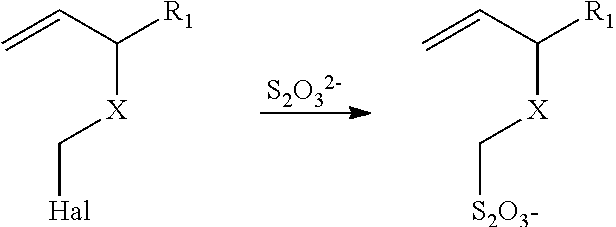Method of sequestering metals using thiosulfate polymers
a technology of thiosulfate and polymer, which is applied in the direction of photomechanical treatment, instruments, electrical equipment, etc., can solve the problems of inability to efficiently decompose bunte salts, inability to use simple patterning thin films using bunte salt polymers, and inability to achieve large-scale production, high adhesive strength, and low cost
- Summary
- Abstract
- Description
- Claims
- Application Information
AI Technical Summary
Benefits of technology
Problems solved by technology
Method used
Image
Examples
##ventive example 1
Inventive Example 1
Photopatterning Thiosulfate Polymer Composition Coating
[0236]To 1 ml of an 11 weight % solution of poly(vinyl benzyl thiosulfate sodium salt-co-methyl methacrylate) (prepared in Synthesis 1) in water, 0.066 weight % of 4-phenyl-N-ethoxy pyridinium hexafluorophosphate of electron-accepting photosensitizes component PS-12, 1.1 weight % of tetrabutylammonium chloride, and 1 ml of tetrahydrofuran was added and then spin-coated onto a glass plate support at 1000 rpm. The resulting coating was protected from UV and blue light at all times. The coating was then dried for 5 minutes on a hot plate at 50° C. The coating was then exposed to light using a mercury lamp through a mask for 10 seconds and then washed with water, followed by washing with acetone. The exposed areas of the coating on the glass plate were rendered insoluble (crosslinked), forming an image corresponding to the mask, whereas non-crosslinked thiosulfate polymer in the unexposed areas of the coating was ...
##ventive example 2
Inventive Example 2
Demonstration of Photoinduced Electron Transfer
[0238]To 1 ml of a 2 weight % solution of poly(vinyl benzyl thiosulfate sodium salt-co-methyl methacrylate-co-acrylic acid-co-N-butyl-N′-[2-(ethoxy-2-acrylate)ethyl]-1,4,5,8-naphthalenetetracarboxylic diimide) (prepared in Thiosulfate Polymer 5) in water, 1 ml of tetrahydrofuran was added and the solution was then spin-coated or to a glass plate support at 1000 rpm. The resulting coating was protected from UV and blue light at all times, and dried for 5 minutes on a hot plate at 50° C. Absorption spectra of the coating were recorded before and after exposure to light. After exposure to light, the characteristic absorption spectrum of naphthalenediimine radical anion (compared with a chemically generated authentic spectrum) was observed. Formation of naphthalene diimide radical anion was concomitant with photo-crosslinking as evidenced by a change in solubility of the coating.
[0239]These results show that the thiosulfa...
##ventive example 3
Inventive Example 3
Photopatterning Thiosulfate Polymer Composition Coating
[0240]To 1 ml of a 2 weight % solution of poly(vinyl benzyl thiosulfate sodium salt-co-methyl methacrylate-co-acrylic acid-co-N-butyl-N′-[2-(ethoxy-2-acrylate)ethyl]-1,4,5,8-naphthalenetetracarboxylic diimide) (prepared as described above as Thiosulfate Polymer 4) in water, 1 ml of tetrahydrofuran was added and the composition was spin-coated onto a glass plate substrate at 1000 rpm. The coating was protected from UV and blue light at all times, and was then dried for 5 minutes on a hot plate at 50° C. The dried composition coating was exposed to light using a Hg lamp through a mask for 6 seconds and then washed with water, followed by washing with acetone. The exposed areas of the composition coating on the glass plate substrate were rendered insoluble (crosslinked) forming an image of the mask, whereas non-crosslinked thiosulfate polymer composition in the unexposed areas of the dried coating was washed away...
PUM
| Property | Measurement | Unit |
|---|---|---|
| Tg | aaaaa | aaaaa |
| Tg | aaaaa | aaaaa |
| Tg | aaaaa | aaaaa |
Abstract
Description
Claims
Application Information
 Login to View More
Login to View More - R&D
- Intellectual Property
- Life Sciences
- Materials
- Tech Scout
- Unparalleled Data Quality
- Higher Quality Content
- 60% Fewer Hallucinations
Browse by: Latest US Patents, China's latest patents, Technical Efficacy Thesaurus, Application Domain, Technology Topic, Popular Technical Reports.
© 2025 PatSnap. All rights reserved.Legal|Privacy policy|Modern Slavery Act Transparency Statement|Sitemap|About US| Contact US: help@patsnap.com



